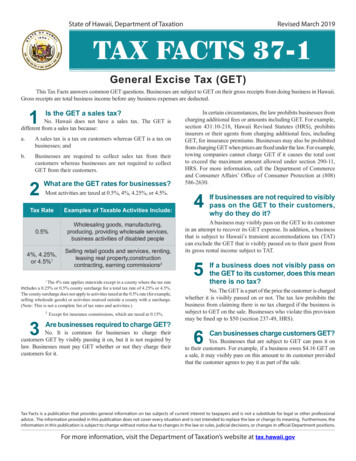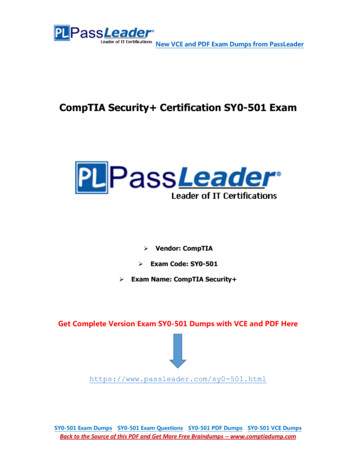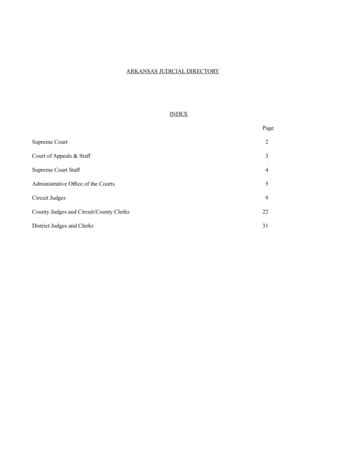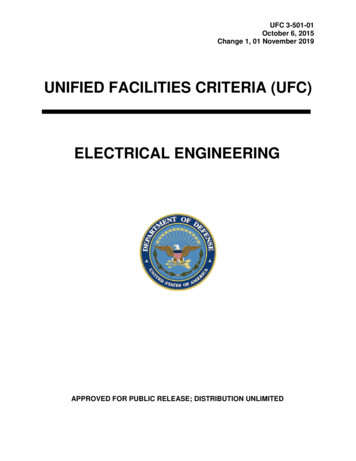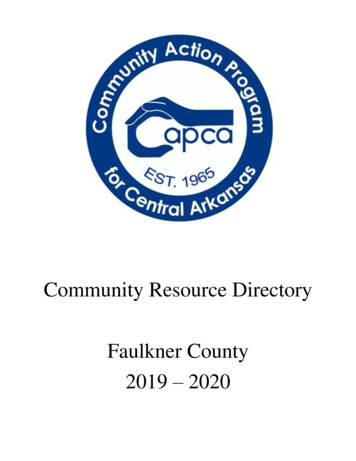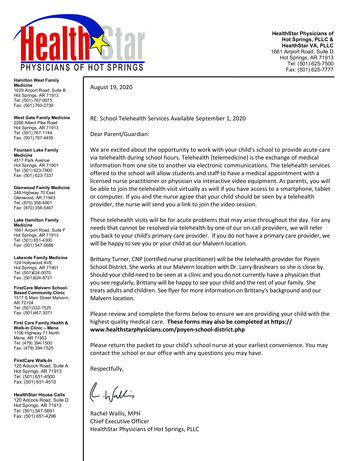
Transcription
501(c)(4) Strategy andDiscussion GuideLogo Style GuidePRIMARY LOGO SIGNATUREThe Atlas Learning Project logo is left-justified in cases when used alone and consists of three mainelements: the primary logotype, “atlas”, the logo icon (double arrows) and the secondary logotype,“LEARNING PROJECT.” All of these elements must be present for the logo signature to be consideredacceptable for print and digital collateral. A specific logo icon will be used in cases where the logo needs tobrand social media sites, such as, Twitter or Facebook (see below).This primary logo signature has been custom-created and should never be recreated or re-typeset. Tomaintain consistency and create a strong visual identity, use the primary logo signature in its digitalformat.PRIMARY LOGOTYPESECONDARY LOGOTYPELOGO ICONSOCIAL MEDIA LOGO ICONA badge for social media purposes, i.e. Twitter or Facebook icon/avatar.LOGO SIGNATURE SIZESIn general, the logo signature must maintain a minimum size of 1.5” wide and 0.229” high, and amaximum size of 2.615” wide and 0.3993” high.MAXIMUM SIZEMINIMUM SIZE2.615”1.5”0.229”0.3993”
THE ATL AS LE ARNING PROJECT is a three-year effortcoordinated by the Center for Evaluation Innovation to synthesizeand strategically communicate lessons from the advocacy and policy changeefforts that The Atlantic Philanthropies and other funders have supported inthe U.S. The project’s goal is to help push philanthropy and advocacy in bolderand more effective directions. To learn more, go to atlaslearning.org.ALLIANCE FOR JUSTICE (AFJ) is a national association of more than 100organizations united by a commitment to a fair, just, and free America, whereeveryone has equal access to justice and can fully participate in our democracy.Learn more at www.AFJ.org.For over 25 years, AFJ has promoted active engagement in the democraticprocess, by giving nonprofits and foundations the confidence to advocateeffectively. Within AFJ, Bolder Advocacy helps foundations and their nonprofitgrantees understand the complex rules governing advocacy and advance theirmission. Bolder Advocacy offers resources, best practices, tools, coaching,and the Technical Assistance Hotline (866-NP-LOBBY). Bolder Advocacyalso works to protect and expand the right of nonprofits and foundations toadvocate. Learn more at www.bolderadvocacy.org.THE ALLIANCE FOR JUSTICE ACTION CA MPAIGN (AFJAC) servesas the nation’s leading resource on the legal framework for 501(c)(4) nonprofitadvocacy efforts. AFJAC provides invaluable resources, training, and technicalassistance to help nonprofit organizations and their donors advocate moreefficiently and effectively.Through the expertise of its knowledgeable team of attorneys, AFJACcontributes respected insight to policy debates on campaign finance, advocacy,and nonprofit tax law issues. AFJAC also promotes a national conversationabout the importance of the courts with a goal of advancing core constitutionalvalues, preserving human rights, securing unfettered access to the judicialsystem, and guaranteeing the even-handed administration of justice forall Americans. 2016 Alliance for Justice and Alliance for Justice Action CampaignCOVER PHOTO: PRESSMASTER/SHUTTERSTOCK.COM
IntroductionThis Strategy and DiscussionGuide has been developedfor individuals, organizations, and funders interested instarting 501(c)(4) organizations. Itdiscusses the strategic questionsthat must be considered in determining whether, when, and forwhat purpose(s) to create a (c)(4).501(c)(4) social welfare organizations are a vital tool for nonprofits and funders seeking to shapepolicy outcomes that benefit theirmembers, constituencies, grantees,and society at large.Establishing, managing, and maximizing the advocacy capacity of a501(c)(4) entails a number of different considerations. Here, we layout those considerations in detailand outline examples of successfulmanagement strategies.A quick overview: What isa 501(c)(4) social welfareorganization?A 501(c)(4) organization is a socialwelfare organization that maypursue educational, lobbying, andsome limited political activities. Nolimit exists on the amount of lobbying a (c)(4) may conduct, includingworking for the passage or defeatof ballot measures. In addition, a(c)(4) may engage in partisan political campaign work, but only as asecondary activity. For a more detailed summary of the legal framework for (c)(4)s, see the Primer onSocial Welfare Organizations: Using501(c)(4) Organizations for Good.Partisan political activity includes: Endorsing candidates or opposing candidates Partisan voter outreach Developing a pipeline of “good”candidates Polling based on swing states/districts/counties or voters Independent expenditures Establishing and/or managing connected political action committees501(c)(4) STR ATEGY AND DISCUSSION GUIDE1
Contributing directly or indirectly to state or local candidates that allow corporate contributions Conducting voter registration orget-out-the-vote (GOTV) drivesaimed at supporting a candidateor partyIt’s important to remember that a501(c)(4) cannot be created for thepurpose of electing or defeating aparticular candidate or candidates.In addition, 501(c)(4) organizationsmust comply with federal and stateelection law when engaging incertain partisan political activities.For example, federal and stateelection rules govern whether a501(c)(4) can make a contributionto a candidate or coordinateactivities with a candidate. It’spossible that your state mayprohibit activities that other statesallow (c)(4)s to conduct, so be sureto check.Unlike contributions to 501(c)(3)organizations, contributions to(c)(4)s are not tax-deductible. Infact, a (c)(4) must notify prospective donors that contributionsare not deductible as charitablecontributions. In addition, (c)(4)s are not required to disclose theirdonors publicly except under verylimited circumstances. For more onthe differences between (c)(3)s and(c)(4)s, see below.2What is the differencebetween a (c)(3) and a (c)(4)?The most common type of tax- exempt nonprofit organization isthe 501(c)(3) group that engages incharitable, religious, scientific, literary, or educational work. It paysno federal taxes on its income, andcontributions it receives may betax-deductible by the donor. Thetwo basic types of (c)(3) groups arepublic charities and private foundations, each subject to somewhatdifferent rules. Importantly, thesegroups are allowed to engage ina broad range of advocacy activities, although they are subject tolimits on lobbying. In the case ofpublic charities, these limits arequite generous. At the same time,though, these organizations areprohibited from engaging in anypolitical activity on behalf of or inopposition to a candidate for publicoffice.Before moving too far down theroad toward establishing a (c)(4),advocates should be clear about thekinds of activities they want to pursue—and whether those activitiescan be carried out by an existing(c)(3). Advocates with an existing(c)(3) should check to make surethey are maximizing their (c)(3)’sadvocacy capacity, for instance,by lobbying up to its allowablelegal limit.ALLIANCE FOR JUSTICE ALLIANCE FOR JUSTICE ACTION CAMPAIGN
Establishing a (c)(4) maybe a good idea if:You believe a robust donorbase is availableWhile (c)(4)s present anexcellent opportunityto engage in unlimited lobbying and limited politicalactivity, raising money for a (c)(4) can be challenging—especiallysince donors won’t receive a taxadvantage as a result of their contributions. Organizations shouldbe prepared to construct a robustfundraising program that combinesindividual and institutional donors.Individuals who care about yourcause are often the best people toapproach first. It’s also helpful totarget donors who have alreadyreceived their maximum charitablededuction under tax law, do notitemize at all, and/or care moreabout the issue and the work thanany potential tax benefits—sincethey will not get a deduction forgiving to your (c)(4). In addition,unions and membership dues mayserve as key sources of funding forthe (c)(4)’s activities.Advocates often ask if 501(c)(3)scan make grants to (c)(4)s; they can,but only for educational, nonpolitical work. Such grants will often betreated as lobbying expenditures bythe (c)(3) making the grant. Publiccharities, including communityfoundations, can fund a (c)(4)’s lobbying. In fact, many public charitiesthat have not exceeded their lobbying limits under the 501(h) electionchoose to grant “excess” lobbyingfunds to a (c)(4). By contrast, due toexpenditure responsibility rules, private foundation grants to (c)(4)scannot be used for lobbying, andtherefore most private foundationsprefer to make grants to charitable501(c)(3)s only.A diversification of funds is important, especially since 501(c)(4) fundraising may suffer in anelection year when likely donors are committed to politicalcampaigns or PACs. Most (c)(4)shave a small donor pool and mustdedicate significant resources toraising money in order to executerobust campaigns.501(c)(4) STR ATEGY AND DISCUSSION GUIDE3
A good example of a (c)(4) organization that has diversified its revenue stream is Equal Voice Action(EVA), founded by the MargueriteCasey Foundation as “an independent, family-led organizationcommitted to ensuring that poorand low-income families have avoice in shaping public policy thatdirectly impacts their daily lives.”1The organization is nonpartisanand funds its activities throughlow-dollar individual and organizational membership dues, grantsand some advertising revenue.If a (c)(4) wants to operate at “fullstrength,” it needs to make sureit has funding from sources otherthan (c)(3)s. For example, duringthe 2014 congressional elections, a(c)(4) wanted to send postcards tovoters in a legislative district criticizing the incumbent’s views onthe budget and encouraging votersto remove him from office. Whileit was a permissible activity for a(c)(4), all of the (c)(4)’s fundinghad come from (c)(3)s, and thuscould not support such politicalactivity. As a result of its fundingstreams, the (c)(4) was limited inthe a ctivities it could do.You need all the tools inthe advocacy toolboxThere are times when simplyengaging in public education isinsufficient to advance policy imperatives or fulfill an organization’smission. Sometimes, advocatesneed to engage policymakers in amore aggressive fashion, throughextensive lobbying or partisanelectoral work. When a (c)(3) groupassesses its advocacy goals andcapacities and contemplates adding(c)(4) capacity it often asks if thereis a need to hold policymakersaccountable, or if it needs unlimited lobbying capacity or the abilityto address legislative positions inthe context of an election. If theanswer to these questions is “yes,”then a charitable organizationshould strongly consider forming a501(c)(4).While (c)(3)s can lobby, they muststay within lobbying limits. Thelimits are usually quite generous,but at times they’re not enough.This is a common reason why—and when—a (c)(3) establishes anaffiliated (c)(4). For instance, theNational Women’s Law Center established the NWLC Action Fundto ensure that grassroots lobbyingcosts wouldn’t swamp the (c)(3)’s1. Action Now October 2015 Newsletter. (2015, October). Where Change Begins.4ALLIANCE FOR JUSTICE ALLIANCE FOR JUSTICE ACTION CAMPAIGN
limits.2 A (c)(4) provides a safetyvalve for when there will be a lot ofgrassroots lobbying.It’s often necessary to employ amix of heightened lobbying andaggressive political activity toachieve policy wins. For instance,the Affordable Care Act wouldnot have passed without bothapproaches, which were part of anextensive campaign led by HealthCare for America Now (HCAN),a (c)(4), heavily funded by TheAtlantic Philanthropies. “HCANdeveloped and executed a comprehensive strategy during the 2008elections, which helped establishhealth care as a priority, framethe debate and build momentumfor reform efforts early in the nextCongressional session . . . . HCAN’sdynamic connection betweenlegislative advocacy and electoralstrategies exemplifies two of thekey attributes of effective advocacycampaigns: developing integratedstrategies and coordinating amongdifferent parts of the campaign.”3Aspart of its campaign, “HCAN targeted several competitive Houseand Senate races in districts wherethe coalition had a base of supportand knew the candidates’ positionon reform. The goal of the ads andfield work was to show that healthcare reform was a pivotal issue inthe decision of the election.”4 Dueto this multifaceted advocacy work,which blended lobbying and political engagement, voters felt morefavorable towards candidates whosupported affordable health care.While it may not always be enoughon its own, advocacy other thanlobbying is often essential to laythe groundwork for later lobbyingand political activity. For instance,the marriage equality ballot measures passed only after advocatesrealized that “the only way tomove forward was to implementa much more effective and trulymulti-dimensional public education, non-political strategy wellbefore a measure appeared on theballot.”5 Funders realized that theyneeded to provide significant fundsso advocates could focus on a keypublic education strategy of “changing hearts and minds . . . . ”6 (C)(3)2. AFJ Interview with Emily Martin3. HCAN Evaluation: A comprehensive qualitative evaluation of the Health Care forAmerica Now campaign, Grassroots Solutions and M R Strategic Services, 17–18.4. Id.5. Hearts & Minds: The untold story of how philanthropy and the Civil Marriage Collaborative helped America embrace marriage equality, Proteus Fund (2015), 9.6. Id.,11.501(c)(4) STR ATEGY AND DISCUSSION GUIDE5
funds—and (c)(3) funders—couldsupport the public education strategy, but funds available for lobbyingwere critical once the ballot measure campaigns were underway.Similarly, efforts to establishfederal death penalty reforms required more than public educationefforts. For example, The AtlanticPhilanthropies funded The JusticeProject, a (c)(4), for a five-yeareducation and lobbying campaignto pass The Innocence ProtectionAct as part of the Justice for AllAct in 2004. As The Justice Projectreported, “Education is absolutely important to create the rightclimate . . . But if you want to bringabout social justice change, youmust engage the legislative andjudicial processes as well.”7As described by Kevin Wernerof Ohioans to Stop ExecutionsAction Fund, a (c)(4) ”helps ensure that the (c)(3) investment ineducation isn’t just left to chance.”8Essentially, a (c)(4) can help closethe deal. In fact, many advocatesand funders remarked that a(c)(4), with its increased lobbyingcapacity and ability to support(or criticize) candidates, is oftenneeded to move an issue across thefinish line.In recent years, the death penaltyreform and abolition movementcontinues to focus on lobbying, fornow eschewing efforts to supportcandidates in favor of focusing onlegislation. Advocates have decidedto focus their limited resourceson lobbying in state legislatures,where they see a window of opportunity to act before the SupremeCourt gets involved. Although the(c)(4) death penalty groups havefocused on lobbying, one fundersuggested a possible reason toexpand their scope into partisanpolitical activities: most deathsentences in this country are carried out in only 25 counties. If thegroups had added resources, it maybe effective to weigh in on stateand local judicial and prosecutorelections.You want a change inelected leadershipSome organizations decide theydo want to help elect (or defeat)candidates, because their mission depends on the right kindof leadership in the legislative orexecutive branch. In these cases,campaign intervention becomesa critical strategy to advance the organization’s cause. As described byNARAL Pro-Choice Virginia, it7. Atlantic Reports: Why Supporting Advocacy Makes Sense for Foundations, 6.8. AFJ Interview with Kevin Werner6ALLIANCE FOR JUSTICE ALLIANCE FOR JUSTICE ACTION CAMPAIGN
is important for the organization tobe able to talk about electing a prochoice majority. NARAL points outthat it does not work for the Democratic Party, or individual candidates. Rather, the group says, “wework for the women of Virginia But to even have this conversation,we need the (c)(4).”9Likewise, various immigrationreform groups have recognized thatto promote favorable policies, theyneed to encourage activists to runfor office. The Latino VictoryFund, for example, has prioritizeddeveloping a pipeline of Latinoleaders that can serve in municipal, state, and national legislativebodies and make better policydecisions.Your advocacy goals requirea public referendumor ballot measureFor a charitable organization,leading a costly ballot measurecampaign while staying within lobbying limits is extremely difficult.Consequently, most ballot measure committees are (c)(4)s. Forinstance, in 2014, the New JerseyWorking Families A lliance, a(c)(4), led a coalition of groups(including (c)(3)s and (c)(4)s) in acampaign to place paid sick dayson the ballot in Trenton and Montclair, New Jersey. Likewise, therecent success of a criminal justicereform ballot measure, Prop 47, inCalifornia was led by Vote Safe, a(c)(4).Some (c)(4)s intentionally keeptheir work on a ballot measure separate from their work on candidateelections. They see an issue, suchas paid sick days, raising taxes, orlegalizing same-sex marriage, asnonpartisan (or bipartisan) and/or want (c)(3)s to participate inthe campaign. On the other hand,the New Jersey Working FamiliesAlliance not only promoted the ballot measures calling for paid sickdays, but also endorsed candidateswho supported pro-working familypositions and paid for ads in support of such candidates. So too did Equality Maryland (along withother equality groups), when it defended a ballot measure permittingsame-sex Marylanders to marry,while simultaneously endorsingcandidates who shared these viewsand helping voters make informeddecisions about which candidatesto support.Your policy issue hasbecome politicizedWe live in a hyper-partisan environment. Politicians and parties9. AFJ Interview with Tarina Keene501(c)(4) STR ATEGY AND DISCUSSION GUIDE7
are taking more extreme stanceson issues like gun control, climatechange and immigration reform,and in their competition for control, are politicizing many issuesthat previously were nonpartisan.Reproductive rights, health, andjustice issues have been consideredpartisan for decades now; the IRShas actually identified words like“pro-choice” and “pro-life” (and“liberal” and “conservative,” amongothers) as “code words” deemed toimprove or diminish the prospectsof certain candidates based on theirviews, even when the candidates’names are not used. Consequently,discussing these issues in connection with voting or candidatescan be quite risky for a 501(c)(3).501(c)(4)s, on the other hand, canaddress these issues with morefreedom and in connection withpolitical parties or campaigns.A (c)(4) can be more direct whentalking about its issues, particularlywhen the issues divide candidatesor parties. As described by TishaReed, former deputy director ofWV FREE and WV FREE ActionFund, a “(c)(4) can much morestrongly endorse policies insteadof providing a balanced picture . . . For things like social mediaand for [talking with] reporters,it’s easier to have a side when youare working from the (c)(4) on [reproductive] issues.”10501(c)(4) status allows a group todiscuss its issues more aggressively and challenge the positions ofpoliticians. For instance, America’s Voice, the 501(c)(4) companion to America’s Voice EducationFund, seeks to “harness the powerof American voices and Americanvalues to enact policy change thatguarantees full labor, civil andpolitical rights for immigrants andtheir families.”11 In the 2016 Republican primary, candidate DonaldTrump made offensive statementsabout immigrants and Muslims.12America’s Voice responded to thecontroversial candidate statements by issuing press statementsand reports that cover the rise inanti-immigrant rhetoric within theGOP and the corresponding negative opinion of the GOP among Latino voters.10. AFJ Interview with Tisha Reed.11. About, America’s Voice. www.americasvoice.org12. When Donald Trump announced his intention to run for President of the UnitedStates, he made many controversial remarks including calling Mexican and Latino immigrants “rapists” and “drug dealers.” In December 2015, Trump suggested that the UnitedStates should ban all Muslims from traveling to the country.8ALLIANCE FOR JUSTICE ALLIANCE FOR JUSTICE ACTION CAMPAIGN
For a (c)(3), weighing the risks andrewards of a response to a candidate’s comment(s) can be a difficult decision. In the 24-hour, socialmedia-driven media cycle, takingtime to weigh the relevant factorsand craft a judicious statementmeans loss of valuable time andimpact. A 501(c)(4) does not havethe same constraints. Also, staffand volunteers of 501(c)(4)s candiscuss issues within the context ofvoting and the attitudes of voters.You need to protect thereputation of the 501(c)(3)An organization seeking to start a501(c)(4) that is connected to anexisting (c)(3) will need to considerwhat a (c)(4) may mean for thenonpartisan reputation of its501(c)(3). The goal of a charitableorganization is to serve its community and to advocate on thecommunity’s behalf, no matter thepolitics of the moment. For thisreason, a connected (c)(4) thataggressively addresses politicalmatters or constantly lobbies, evenif nonpartisan, could potentiallysully the nonpartisan reputationof its connected parent (c)(3) organization.After conducting several focusgroups and meeting with a varietyof grantees and other stakeholders,the Healthcare Foundation ofGreater Kansas City (HCFGKC)ultimately decided not to establishan affiliated (c)(4). While there wasgeneral agreement that a (c)(4)would create opportunities—theability to spend more money onlobbying, hold legislators accountable, build a pipeline of candidatesto run for office, and encourageother funders to support (c)(4)work—there was concern that thefoundation and its grantees wouldlose their credibility and reputations would be damaged if the(c)(4) was seen as partisan.From a strategy standpoint, groupsshould consider their issues andmissions in the context of thepolitical environment. For some,using the power of a (c)(4) toleverage advocacy is unnecessary.But for some organizations, a501(c)(4) provides maximumprotection of tax-exempt status,coupled with the flexibility toutilize several advocacy tools toaccomplish their mission and servetheir constituents.501(c)(4) STR ATEGY AND DISCUSSION GUIDE9
10ALLIANCE FOR JUSTICE ALLIANCE FOR JUSTICE ACTION CAMPAIGN
Best Practices for Setting up aRelated (c)(3) and (c)(4)Given the ability of (c)(4)sto engage in extensive lobbying and some politicalactivities, a (c)(3) active on publicpolicy issues might consider establishing an affiliated (c)(4). Here aresome tips for how to do it smartly.Sufficiently separatethe entitiesThe (c)(3) and (c)(4) must belegally separate and distinct corporations. Despite having similarmissions and goals, an affiliatedsocial welfare organization is aseparate organization in the eyes ofthe IRS. The affiliated organizationshould have a separate EIN (tax IDnumber), separate bank accounts,a different name, and differentlogo. Often, the name and logosare similar to that of the (c)(3) foruniformity and recognition’s sake.The (c)(4) should have a board ofdirectors separate from that of the(c)(3). The organizations may haveboard overlap, but if the (c)(4)engages in partisan politicalactivity, complete board overlap isill-advised.When Save the Children recognizedthe need for a (c)(4) to carry outwork not allowed by the (c)(3), ithad a debate about whether the(c)(4) should be affiliated with the(c)(3) or a completely free-standingentity. Initially, there was concernabout confusion and damage to thereputation of the (c)(3) with anaffiliated (c)(4). Ultimately, Savethe Children decided to establishan affiliated entity, Save theChildren Action Network(SCAN), but hired mostly separatestaff that work out of separateoffice space. However, to maintainsome alignment between theorganizations, they share a fewoverlapping board members, theCEO of the (c)(3) chairs the (c)(4)board, and the organizations meetquarterly to stay in touchabout activities.The National Employment LawProject established a (c)(4) largelyto allow it to discuss candidates501(c)(4) STR ATEGY AND DISCUSSION GUIDE11
and hold leaders accountablewhile minimizing legal or reputational risk. Only a few NELPstaff work on behalf of the (c)(4),the National Employment LawProject Action Fund. To makeit easier to manage and to reducecompliance burdens, it uses a fiscalsponsor, The Advocacy Fund.Healthier Colorado, a nonpartisan 501(c)(4) organization, wascreated and initially funded by theColorado Health Foundation,which at the time was a publicfoundation (although it has sincetransitioned to a private foundation). Due to the Foundation’stransition to a private foundation,it chose to create strong firewallsbetween the (c)(3) and the (c)(4).The names, logos, website staffs,and even office spaces are different.A 501(c)(3) organization and itsrelated 501(c)(4) organization mayavoid some problems by havingseparate websites. However, undercertain circumstances, it is possibleto maintain a joint 501(c)(3)/501(c)(4) website. First, if thewebsite is owned by the 501(c)(3)organization, and the 501(c)(4)does not engage in any politicalactivity, the 501(c)(4) may pay topost material on the 501(c)(3)’swebsite. Second, if the website isowned by the 501(c)(4), and the12501(c)(3) organization pays to postmaterial on the site, that activitymay be permissible. However, ifthe website is owned by the501(c)(3), and the 501(c)(4)conducts political activity, thepolitical material on the jointwebsite may be attributed to the501(c)(3), resulting in a violation ofthe 501(c)(3)’s tax status.Websites of many (c)(3) organizations, such as the ACLU ofMaryland Foundation and PlannedParenthood Federation of America,are very transparent when a sitevisitor is navigating away from the(c)(3) site to the (c)(4) site. Thesesites present a pop-up box thatinforms visitors they are jumpingto another site. For example, theACLU’s pop-up message reads,“You are leaving the ACLU of Maryland Foundation (c)(3) website andgoing to the ACLU of Maryland(c)(4) website.” The site visitormust then click “OK” to continue.This leaves the visitor with no confusion about which organization’swebsite they are visiting.While there are best practices forhow to operate, it is up to each“family” of organizations to determine how closely—or how farapart—the organizations operate.“My main piece of advice,” saysChristopher Hansen, president ofthe American Cancer SocietyALLIANCE FOR JUSTICE ALLIANCE FOR JUSTICE ACTION CAMPAIGN
Cancer Action Network, “is youwant to be very, very careful aboutmaking sure that you’re makingthe separation as distinct as possible. It needs to be able to withstanda rigorous audit trail.”13Set up good compliancesystems from the startRegardless of how groups decide tohandle recordkeeping, accounting,and other administrative tasks,several former Atlantic Philanthropies program officers encouragegroups to set up good legal compliance systems from the start.Although the affiliated organizations may have similar names andshare staff and office space, theyare legally separate entities. The(c)(3) cannot subsidize the activities of the (c)(4), so it is criticalthat the (c)(4) pays at least its “fairshare” of all expenses. Organizations that share office space,equipment, and staff, for instance,should execute a cost-sharingagreement that specifies thepayment terms, and have timesheets to allocate staff timebetween organizations. Likewise,affiliated organizations need toconsider how to manage lists,websites, social media, and evenprogrammatic activities. Oneprogram officer even recommendsthat funders provide support tohire a lawyer or other compliancespecialist to devise recordkeepingand financial protocols, hoping that“seal of approval” may encourageother foundations to fund the work.Train staff for complianceMaintaining and operating an affiliated (c)(4) requires knowledgeable staff. This doesn’t mean thateveryone on staff understands theins and outs of (c)(3)/(c)(4) interactions, but there must be a basicunderstanding of when to allocateone’s time to the (c)(3) and whento allocate time or activities to the(c)(4). Organizations should havea dedicated staffer to manage thecompliance issues and boundariesbetween the (c)(3) and (c)(4), andto develop policies and proceduresto ensure consistency.Additionally, administrative staffmust understand the reimbursement procedures when movingmoney from a (c)(3) to a (c)(4)and vice versa. Groups that decideto form a (c)(4) must understandthe importance of maintainingaccurate paperwork, and not allowing money to slush between theorganizations without accountabil-13. Advocacy for a Smoke-Free Nation, Bolder Advocacy Interview with ChristopherHansen.501(c)(4) STR ATEGY AND DISCUSSION GUIDE13
ity. While there are administrativecosts associated with this vigilance,advocates insist they should notbe seen as a barrier but as a cost14of d oing business—or advocacy— better.ALLIANCE FOR JUSTICE ALLIANCE FOR JUSTICE ACTION CAMPAIGN
For More InformationVisit these user-friendly onlineresources: Primer on Social WelfareOrganizations: Using 501(c)(4)Organizations for Good The Connection: Strategiesfor Creating and Operating501(c)(3)s, 501(c)(4)s andPolitical Organizations Influencing Public Policy in theDigital Age Alliance for Justice ActionCampaign Resources andSample Documents501(c)(4) STR ATEGY AND DISCUSSION GUIDE15
11 DUPONT CIRCLE NW, 2ND FLOORWASHINGTON, DC 20036PHONE: 202.822.6070 FAX: 202.822.
4 ALLIANCE FOR JUSTICE ALLIANCE FOR JUSTICE ACTION CAMPAIGN A good example of a (c)(4) organi-zation that has diversified its reve-nue stream is Equal Voice Action (EVA), founded by the Marguerite Casey Foundation as "an inde-pendent, family-led organization

